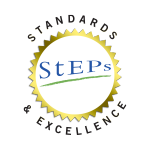 Exciting changes are happening at the more than 1,000 organizations taking part in the StEPs program (Standards and Excellence Program for History Organizations).
Exciting changes are happening at the more than 1,000 organizations taking part in the StEPs program (Standards and Excellence Program for History Organizations).
Our “StEPs Spotlight” blog series highlights accomplishments by participating organizations.
Below is another example of how StEPs is helping organizations take a leap forward by improving policies and practices, opening lines of communication, and setting goals for a bright future.
McHenry County Historical Society & Museum
Union, Illinois

By Kurt Begalka, McHenry County Historical Society & Museum
Since the mid-1960s, the McHenry County Historical Society & Museum has striven to engage and educate current and future generations about the history of their county. Besides operating the museum, the society places plaques at historic sites and structures, hosts workshops and classes, hosts two large festivals a year, runs a research library, makes available satellite exhibits, and arranges a wide variety of school and other group programs. With four staff, MCHS has been a member of AASLH since 1964 and began the StEPs program in 2017.
Can you describe how your organization is making its way through the program?
In a nutshell, we are tackling StEPS like a beaver fells an aspen: chipping away one section at a time! MCHS created a task force to evaluate each section that was made up of board and staff members. Each task force was led by a chairperson. It took two to three meetings to cover each section which occurred once a month. Each task force evaluated MCHS among the Basic, Good, and Better categories. After each section was completed, the task force wrote up a list of project recommendations for every standard. The evaluation of the StEPs sections was completed in late spring of 2018.
The MCHS strategic planning committee reviewed all the project recommendations and prioritized them into three categories. Priority 1 was to be worked on during the 2018-2019 fiscal year. Priority 2 is to be worked on during our current fiscal year 2019-2020. Priority 3 is to be worked on next fiscal year 2020-2021. The priorities were all compiled into charts and the MCHS committees were assigned to priorities by the strategic planning committee. In late summer of 2018, all board members and staff received binders detailing the priorities and project recommendations. Each committee was directed to review the StEPs projects and select 2-3 goals. The strategic plan committee advised the MCHS committees to focus on Priority 1’s that covered key areas of focus: data gathering, policy reviewing and revising, volunteer management, and buildings and grounds. Committees were asked to submit their goals to the strategic planning committee in October 2018. Each month, before a board meeting, committee chairs were asked to submit reports detailing progress on their StEPs goals to the strategic planning committee. Committees that reported progress were acknowledged at each board meeting. Committees that did not provide reports were identified and reminded to submit their reports. The 2018-2019 fiscal year helped MCHS review, revise, or create several policies, began data collection with surveys and focus groups, and write a new Strategic Plan for 2019-2022.

The Gannon cabin, built in 1842, was moved to Union in 1966.
What would you say is the most significant change or improvement within your organization as a result of taking part in StEPs?
Most boards are a little like teenagers. They have to hear it from someone else before they really believe it. StEPs provided us with a sounding board and road map for making tangible improvements. Self-improvement is now front and center in our work.
Which section of the workbook has been your favorite, and why?
The policy part of the Mission, Vision, and Governance section demanded that we re-examine our mission, vision, and values… and make sure that ALL of our actions aligned with them. StEPs can be brutal, in a way. It shines a light on everything, even the warts. But wouldn’t you rather tackle these issues now rather than wait for a “crisis” in the future?
What advice do you have for organizations just starting in StEPs?
It is easy to get overwhelmed. Take it section by section, topic by topic. You’ll find most things are interconnected. But, then again, you knew that already. For us, tackling this process as part of our strategic planning process and utilizing a board retreat to help lay that foundation were pivotal.



